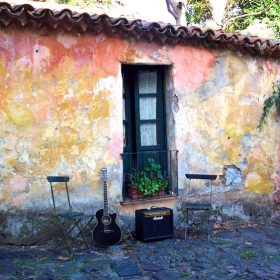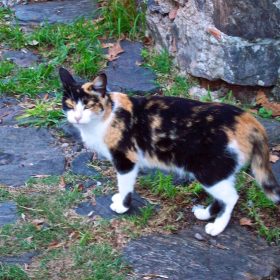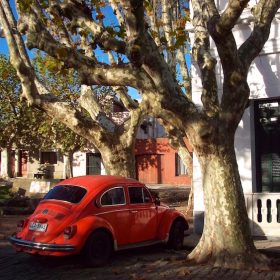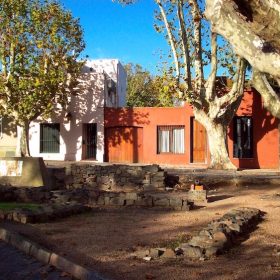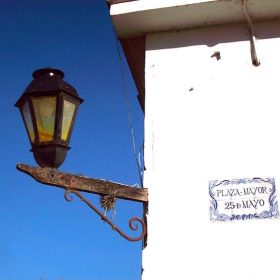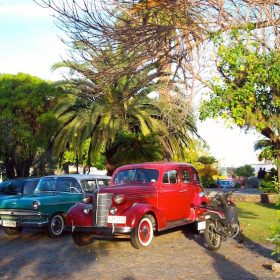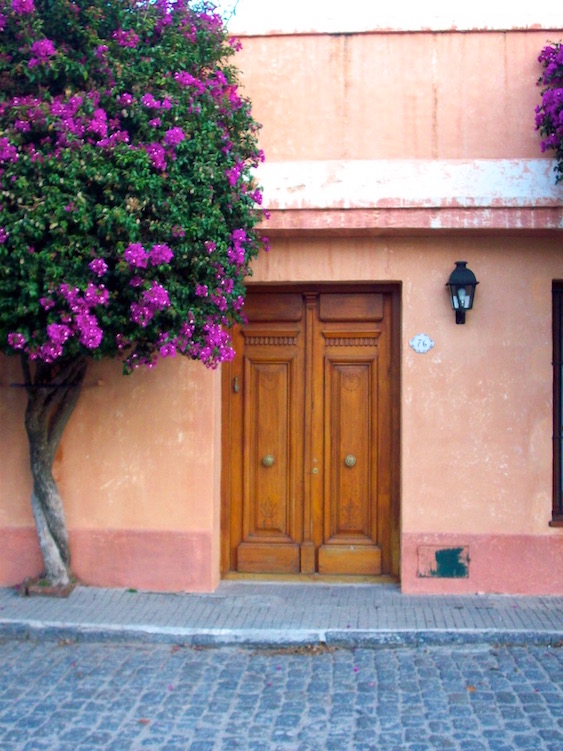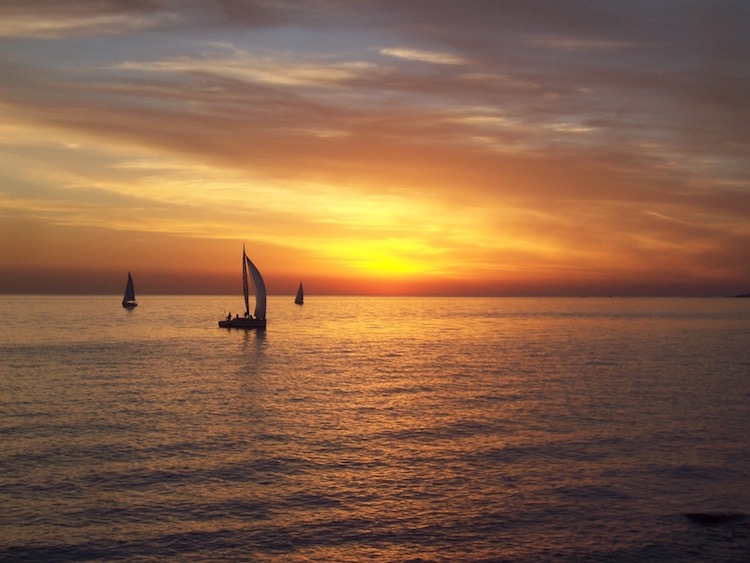One day in Colonia…
A moment in time that will always be with me, I learned to trust in the unknown with a calm confidence…and it all happened one day traveling around Colonia, Uruguay.
Colonia del Sacramento is a little, historic town located in southwestern Uruguay on the Rio de la Plata River across from Buenos Aires, Argentina. In 1680, the Portuguese explorers established Colonia as one of its colonies. Spanish explorers who had settled across the river, conquered Colonia and then relinquished control back to the Portuguese many times over a 140 year period. The area is a key strategic location where the mouth of the river meets the Atlantic Ocean.
Getting to Colonia is an easy ferry ride from Buenos Aires, Argentina. The high-speed Buquebus ferry takes about an hour to cross the river. Remember to bring your passport to enter Uruguay and have your Argentinian proof of reciprocity fee payment ready to present to Argentinean customs on your return (for U.S., Canadian, and Australian citizens and perhaps others).
Grab a map of the historic town from the tourism center near the ferry terminal. The walk to the old town is not very far, perhaps 10 minutes or so by foot or you can opt to rent a bike or take a short taxi ride.
The old, rustic Colonia town is preserved in time. It has an old Spanish-Western feel similar to that of old San Antonio Texas. Vintage greens and yellows, earthen browns, rust reds, and steel blue pastel hues paint the town.
The area exudes a sort of peacefulness. Sailboats traverse lazily along the river in a quiet social gathering. Even the dogs are content – I saw this dog lying outside the door entrance with its head down and eyes looking up. I took his picture, a first of many the beautiful photographs of the town over the day’s excursion.
It was a warm, sunshine day when I visited with my Australian friend Alana. Along the edge of the old town’s border were some unassuming souvenir stores tucked away into a little alley shaded from the sun. A sweet woman running one of the shops was knitting a wool sweater. I bought a sheepskin wool hat that I wear during the winter months walking around in New York City. It has proven to be the warmest, softest hat I have owned, and it protects well during the cold, snowy days in the North.
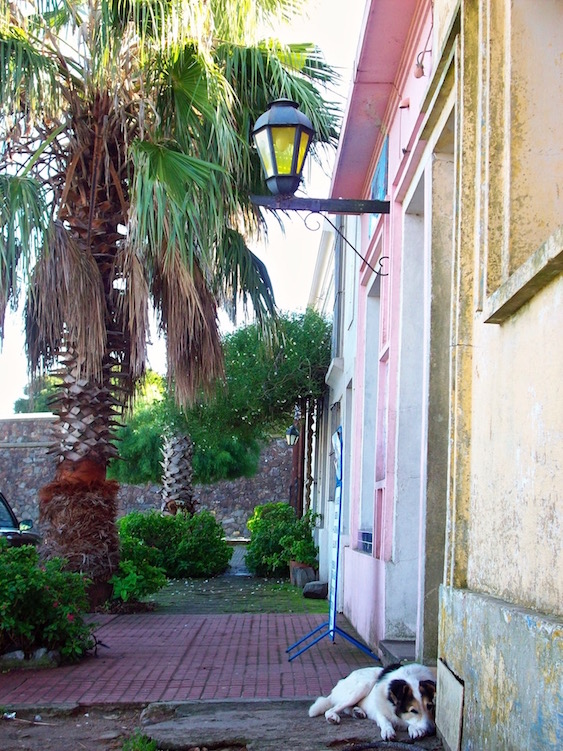
Sites to See Walking Around Colonia Uruguay
- Plaza Mayor
- Portón de Campo – the City Gate and wooden drawbridge
- 17th century Convent of San Francisco
- The Lighthouse
- Basílica del Santísimo Sacramento – built by Portuguese in 1808
- Portuguese Museum – constructed in the 18th century showcasing Portuguese furnishings, jewelry, uniforms and old maps of Portuguese naval expeditions
- Casa de Nacarello – an 18th-century Portuguese house
- Municipal Museum – rebuilt by the Spanish in 1835 as the Casa del Almirante Brown featuring exhibits of the city’s different periods and cultures
- Viceroy’s House – the Casa del Virrey reconstructed from the original ruins
- Plaza de Toros Real de San Carlos – an abandoned bullring built in 1910 and only hosting 8 bullfights
We entered into the main area of the town through the wooden drawbridge of an old, tall stonewall known as the Portón de Campo or the City Gate.
After surveying the main area around the Plaza Mayor, we chose to grab some lunch at a small restaurant with outdoor seating. We ordered some fresh empanadas and toasted chicken sandwiches with lettuce, tomato, cheese and a fried egg, a version of a common Uruguayan snack known as the chivito.
On a cobblestone road parallel to us, I could hear two musicians play a steel guitar and a harmonica. The musical sounds created a cowboy western vibe, as if the musicians were playing by a campfire under a blanket of starts at night.
Quickly finishing my lunch and a cold cerveza on a hot day, I walked down the cobblestone road towards the two musicians. A young man wearing a flat cap and a black flannel shirt strummed the steel guitar and a young woman wearing a purple shirt and colorful matching pink and purple pants played the harmonica. Their improvised melodies were soulful, slow, and serious. It evoked feelings of hardship yet determination, suggesting that although life can be difficult, through perseverance, every one of us can survive and thrive.
This street is called Calle de Sacramento and it leads to the river’s edge. The antique buildings that line the street are made out of terracotta tile, brick, and stone. The color schemes of the area are of paintbrush strokes of earthen browns, rust rose, golden yellows, and leafy greens. Above the structures and in the distance, a hearty South American palm tree stands tall along with other trees. Life and time are suspended and preserved in this moment.
Tourists strolled past the two musicians at a leisurely pace. A calico cat sat at a distant watching them and eventually moved over a few steps to an open door of a tapas restaurant, waiting for the possibility of getting fed.
Right then I had this epiphany. I understood to trust in the unknown. Let the path to the future just unfold and flow like the river. Be open to life as it happens for every day is a new day. It was such a strong moment that still sits with me like a fresh memory. I captured that moment on video and re-watch it time and again. The music still affects me just as it did that day.
I was compelled to capture this moment in an oil painting, a medium that perfectly matches the colorful town of Colonia. The artist is Yiuming “Andrew” Lo.
Compare My Video of These Musicians with the Finished Oil Painting Below:
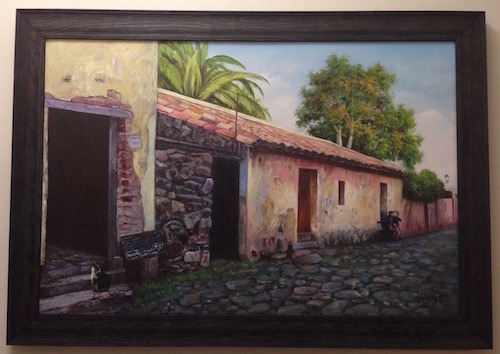
I enjoyed the music. It pacified me during this time when I was feeling stressed and uncertain about the direction my life was going. For one thing, I was out of work for an extended period of time after spending a long number of years in a stressful Wall Street investment banking environment before, during, and after the massive financial crisis in 2008. In thinking about what was next for me, I was frustrated about the past, worried about the future, and agonized about unknown.
But this music comforted me.
Immediately I could feel the sunshine on my face, and I smiled with reckless abandon, as they say. At that moment, I let all of my worries go. I knew then and there to have faith that things will work themselves out the way they do. Be open to life as it happens for every day is a new day. You never know what is around the corner!
With this brand new understanding, I thought to myself “I love life,” and then I wholeheartedly knew the statement to be true. Life is good. Life isn’t always “great” but it’s good. It can be hard and challenging, but life is good.
The only constant in life is change and that change creates opportunity. Things will change—they do all of the time. Too many variables exist around us in life that we cannot control. Even a change in one of these variables could create an opportunity tomorrow that was not here today.
I am seeing that things do work out; they just need time. The universe conspires to give what we need, not what we want. So a time of difficulty may be an opportunity for reflection and spiritual growth and for knowing strength, trust, and resolve in a time of uncertainty.
After times of struggle and hardship, we emerge stronger, better, more loving, and appreciative. Struggle is temporary: This too shall pass as the famous adage goes. When looking back at hardship, a sense of pride can be felt in perseverance through tough moments. It is what makes heroic stories, really.
I found peace in that musical moment on Calle de Sacramento and understood the importance of patience.
I resisted leaving but finally relented to satisfy my curiosity about the rest of the old town.
Discovering Colonia
We walked around and spotted an old Volkswagen and other vintage cars in perfectly restored conditions that sparkled in the sun. Then we stopped inside a stone cathedral church, the Basílica del Santísimo Sacramento, and saw the rays of sun peer through from the tiny window slits. From there we explored the rest of the little town, looking for more souvenirs and tasting the ice cream.
Colonia is known for its wrought iron gas lamps paneled with yellow colored stained glass. Typically, these gas lamps hang at the corners high up at the buildings’ edge. They make for great photographs.
We considered climbing up the stairs of the white lighthouse that stands tall around the town, but we opted, instead, to sit along the river’s edge watching the sailboats. Some of the best sunsets in South America are in Colonia, and it did not disappoint. Watching the sunset was the reason we came for the day to Colonia from Buenos Aires.
The sky turned golden and then a dusty rose to match the pastel colors of Colonia. The petite river waves were illuminated peach and burnt orange colors. The moment was quiet yet powerfully beautiful.
The sun rose and set this way in the early days of Colonia. In the 1600s, the Portuguese and Spanish explorers trusted the unknown when they sailed out towards the horizon, seeking the answers to their curiosities about the world. New experiences awaited.
They survived the journey across the Atlantic to South America, and in doing so; they established this beautiful city, Colonia. Good things are always around the corner!
Back in New York…
Several months after returning from my South American trip, I went to the Metropolitan Museum of Art in New York City. A person was selling his artwork on the sidewalk in front of the museum. I saw a beautiful, intriguing oil painting and asked him if he was the artist. He was – Yiuming “Andrew” Lo.
I saw a second picture that Andrew painted of a bicycle in front of a colorful apartment in an Italian city. The color scheme and the brushstrokes reminded me of the feel of Colonia. Right there I found it – Andrew would paint that moment in Colonia for me.
I showed him the video of the two musicians playing that lovely tune on Calle de Sacramento and asked if he could paint this scene as an oil painting. He agreed and a few days later, we met again, this time in the Hall of Sculptures inside the Met. I brought my computer to the museum and there we reviewed all of these beautiful inspiration photos from Colonia and watched the video again.
Andrew knew what I wanted: The pastel coloring, the detail of the two subjects and of the cat, and the rustic style. In a little less than 8 weeks, Andrew completed the painting. The realism is striking. Now I have this artwork hanging prominently on the wall in my apartment.
Whenever I doubt myself or have doubt about the future, I look to this painting and I am reminded of what I discovered on that day in Colonia. Trust in the unknown. Have faith that things work themselves out. Life may take twists and turns but through perseverance, hope, and love, a new day is just around the corner waiting to be revealed.


